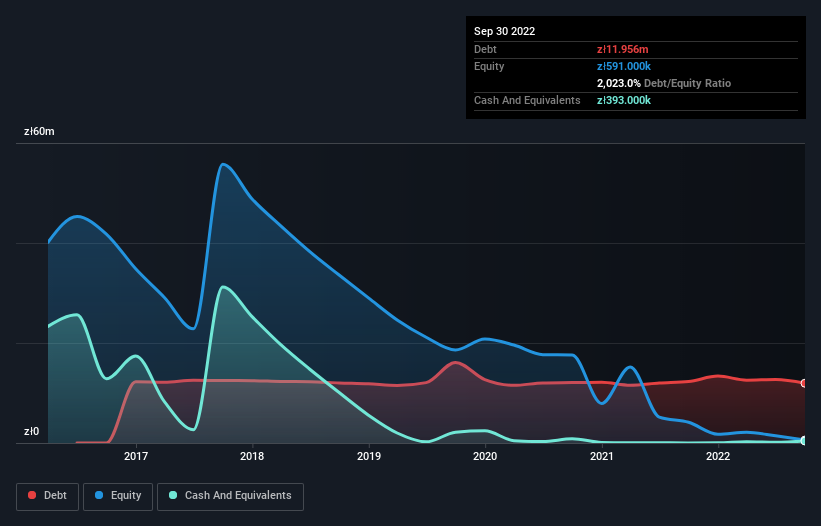
David Iben put it well when he said, 'Volatility is not a risk we care about. What we care about is avoiding the permanent loss of capital.' It's only natural to consider a company's balance sheet when you examine how risky it is, since debt is often involved when a business collapses. We can see that Braster S.A. (WSE:BRA) does use debt in its business. But the real question is whether this debt is making the company risky.
What Risk Does Debt Bring?
Debt and other liabilities become risky for a business when it cannot easily fulfill those obligations, either with free cash flow or by raising capital at an attractive price. Part and parcel of capitalism is the process of 'creative destruction' where failed businesses are mercilessly liquidated by their bankers. However, a more frequent (but still costly) occurrence is where a company must issue shares at bargain-basement prices, permanently diluting shareholders, just to shore up its balance sheet. Of course, debt can be an important tool in businesses, particularly capital heavy businesses. The first step when considering a company's debt levels is to consider its cash and debt together.
Check out our latest analysis for Braster
How Much Debt Does Braster Carry?
As you can see below, Braster had zł12.0m of debt, at September 2022, which is about the same as the year before. You can click the chart for greater detail. However, because it has a cash reserve of zł393.0k, its net debt is less, at about zł11.6m.

A Look At Braster's Liabilities
Zooming in on the latest balance sheet data, we can see that Braster had liabilities of zł18.8m due within 12 months and liabilities of zł4.12m due beyond that. Offsetting this, it had zł393.0k in cash and zł558.0k in receivables that were due within 12 months. So it has liabilities totalling zł21.9m more than its cash and near-term receivables, combined.
When you consider that this deficiency exceeds the company's zł16.8m market capitalization, you might well be inclined to review the balance sheet intently. Hypothetically, extremely heavy dilution would be required if the company were forced to pay down its liabilities by raising capital at the current share price. The balance sheet is clearly the area to focus on when you are analysing debt. But it is Braster's earnings that will influence how the balance sheet holds up in the future. So if you're keen to discover more about its earnings, it might be worth checking out this graph of its long term earnings trend.
In the last year Braster wasn't profitable at an EBIT level, but managed to grow its revenue by 204%, to zł1.2m. That's virtually the hole-in-one of revenue growth!
Caveat Emptor
Over the last twelve months Braster produced an earnings before interest and tax (EBIT) loss. Indeed, it lost a very considerable zł2.2m at the EBIT level. Considering that alongside the liabilities mentioned above make us nervous about the company. We'd want to see some strong near-term improvements before getting too interested in the stock. Not least because it burned through zł2.2m in negative free cash flow over the last year. So suffice it to say we consider the stock to be risky. When analysing debt levels, the balance sheet is the obvious place to start. But ultimately, every company can contain risks that exist outside of the balance sheet. Case in point: We've spotted 4 warning signs for Braster you should be aware of, and 3 of them are a bit unpleasant.
Of course, if you're the type of investor who prefers buying stocks without the burden of debt, then don't hesitate to discover our exclusive list of net cash growth stocks, today.
Valuation is complex, but we're here to simplify it.
Discover if Braster might be undervalued or overvalued with our detailed analysis, featuring fair value estimates, potential risks, dividends, insider trades, and its financial condition.
Access Free AnalysisHave feedback on this article? Concerned about the content? Get in touch with us directly. Alternatively, email editorial-team (at) simplywallst.com.
This article by Simply Wall St is general in nature. We provide commentary based on historical data and analyst forecasts only using an unbiased methodology and our articles are not intended to be financial advice. It does not constitute a recommendation to buy or sell any stock, and does not take account of your objectives, or your financial situation. We aim to bring you long-term focused analysis driven by fundamental data. Note that our analysis may not factor in the latest price-sensitive company announcements or qualitative material. Simply Wall St has no position in any stocks mentioned.
About WSE:BRA
Braster
Braster S.A. provides in-home breast cancer examination device worldwide.
Slightly overvalued with imperfect balance sheet.
Market Insights
Community Narratives



